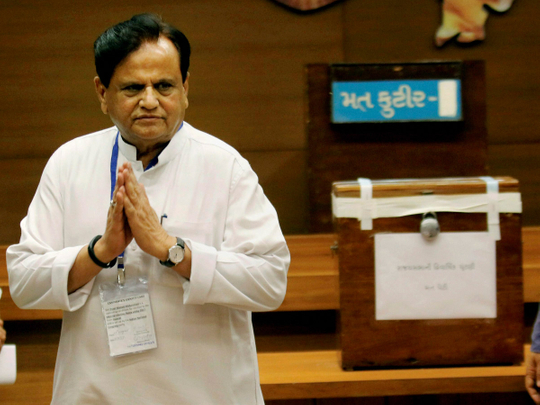Ahmedbhai Mohammedbhai Patel, treasure of the Indian National Congress, passed away in a Gurgaon hospital early on Wednesday morning. The 71 year old was suffering from post-Covid complications. Known by his initials AP within his party, he was inarguably the most important person after the Nehru-Gandhi family that heads India’s main opposition party. The Gandhi family was the face, he was the machine.
In this role he came to develop a reputation of a master strategist, someone in the mould of Chanakya, the Indian equivalent of Machiavelli. Patel was from the western state of Gujarat, which is also where India’s Prime Minister Narendra Modi was from, as is Modi’s own ‘Chankyan’ aide, Amit Shah, the country’s Minister for Home Affairs. Whole Modi-Shah represent and champion Hindu nationalism, Patel as a Muslim being so important in the Congress party was an example of Indian secularism, which recognises there’s more to a person than his religion.
It could be said that the Congress party’s Chankaya from Gujarat was outfoxed by his fellow Gujaratis in 2014. In the time since then, Modi and Shah have expanded the footprint of their Bharatiya Janata Party, weakening the Congress to the extent that it looks flailing at best. Yet even in this dominant BJP era, Ahmed Patel had his moments.
More by the writer
In 2017, Ahmed Patel was seeking re-election the Rajya Sabha, the upper house of the Indian Parliament. Members to the Rajya Sabha are elected by sitting lawmakers in the state assemblies. Since the numbers are known, most candidates are elected unopposed. But the BJP put up a candidate against Ahmed Patel. It was clear that Amit Shah was trying to defeat Ahmed Patel, an open signal to Congress lawmakers to rebel.
It’s the sort of thing the BJP has been very good at, doing everything it takes to win every single election. After all, the Chankyan advice most well-known in popular culture is to use peaceful negotiation, allurement, punishment or divide and rule (“saam, daam, dand, bhed” in Hindi). This Rajya Saha election was a battle of prestige. One master strategist was trying to defeat another.
Ahmed Patel’s defeat would have been a huge humiliation for the Congress party as well as its top leader, Sonia Gandhi. It would have been a big blow — one more of many big blows — to the balance of power between the BJP and the Congress. Yet for all the tactics employed by Amit Shah, Ahmed Patel managed to win.
There were many counts on which the Sonia Gandhi-Ahmed Patel team did not succeed or made blunders. These include not being able to revive the party in Uttar Pradesh or Bihar, not being able to manage a smooth transition to a younger leadership, losing the state of Andhra Pradesh because they did not want to bend before a young leader. One could list many more. But his greatest success wa sin protecting the image of Sonia Gandhi.
Back room strategist
Ahmed Patel emerged in the ‘90s as a back room manager who shunned limelight for himself and would do anything for his boss Sonia Gandhi. The word we have heard the most in the condolence message is loyalty. He was fiercely loyal to Sonia Gandhi and would do absolutely anything for her. If she was the monarch, he was the general. This is different from loyalty to party. For him, Sonia Gandhi was the party. For Sonia Gandhi, he ran the affairs.
Sonia Gandhi has maintained a quiet distance from the hurly-burly of Indian politics while remaining a key figure. She was able to do so because Ahmed Patel ran the party, keeping her interests in mind above everything. The party was run by a non-Gandhi leadership from Rajiv Gandhi’s death in 1991 until Sonia Gandhi took over in 1998.
Sonia Gandhi’s taking over the part was a bit of a coup, and Ahmed Patel was part of the army. Soon thereafter, she staked claim to form a coalition government in 1999 but did not have the numbers. That’s when Ahmed Patel started to build bridges with regional parties and their leaders. It was an art he excelled at: saam, daam, dand, bhed. He knew the art of the possible.
That’s how the Congress was able to stitch together a coalition in 2004, when Manmohan Singh was made prime minister. The allies included India’s Communist parties who opposed the Manmohan Singh government’s decision to sign a civil nuclear deal with the United States in 2005. If the Communists withdrew support, the government would fall. Once again, Ahmed Patel saved the day by replacing the Communists with other allies.
One of India’s most important people
The Manmohan Singh government ran India from 2004 to 2014. In these 10 years, Ahmed Patel was one of India’s most important people, without holding any executive office. Starting 2011, the government became unpopular and its defeat in 2014 gave way to the Modi era.
The Congress party has shrunk substantially on all electoral indicators across the country. Yet no criticism has come Sonia Gandhi’s way. It is only her son Rahul Gandhi, who’s got all the flak. The truth is that the Congress party’s stagnation has been consistent over the years, an odd victory here or there notwithstanding.
In any other party, the top leader would have faced rebellion. In the BJP, LK Advani exited, paving way for Modi. In Sonia Gandhi’s case, there is no criticism, leave alone revolt. The credit for cultivating Sonia Gandhi’s image as being above the fray, stateswoman-like, giving it a sense of mystique and making her unassailable, goes to Ahmed Patel. He had one job, and he did it extremely well.
In her condolence message, Sonia Gandhi described Ahmed Patel as “irreplaceable comrade, faithful colleague and friend”.



